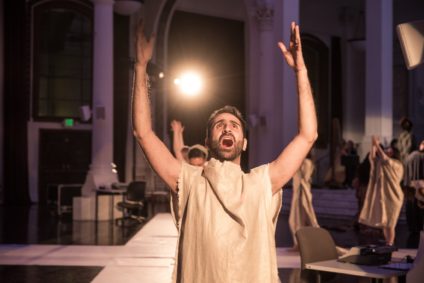
1. What led you to the kind of work you make now?
Like most singers I got my start as a young musician in chorus and musical theater, which was very much in line with my own interests in literature and story-telling. Most of my work for the last few years has been focused on creating narrative pieces for vocal ensembles, but recently I’ve turned my attention to voice and electronics. Mostly it started as a practical choice. I liked the flexibility and mobility of having a solo set I could perform with minimal fuss, but once I got into the world of electronics I fell for the expansive sound palette. I think it has allowed us to replace the dinosaur of the symphonic orchestra; now we can get all that sound and power with just a single performer without compromising the diversity of sounds available.
2. Who are some other musicians and/or artists you admire and why?
My two biggest heroes are Meredith Monk and Toby Twining. They both do similar work exploring the sound possibilities of the voice but approach it from dramatically different angles. Monk comes from this deeply intuitive, almost folk music-like world where she embraces the oral tradition, often teaching her music by rote instead of offering notated scores. Her genius is apparent when you realize how impossible it seems to create something as intricate and complex as her music without any of the instructions being written down.
By contrast, Twining has some of the most intricate manuscripts I’ve seen. He’s a specialist in extended just intonation, and his deep knowledge of theory is painted all over his scores. And yet, when you hear the music, it also has an intuitive folk-like quality to it based in deeply memorable melodies.
At different points in my studies I’ve tried to be one or the other, but I’ve realized my own path is somewhere in between the traditional approach of theory-based, detailed score writing, and intuitive, aural and improvisation-based composition techniques.
3. What are you listening to these days?
Greta Van Fleet. I heard them on the radio recently and was shocked to learn it wasn’t actually a Robert Plant side project. I went out and bought the album immediately. They are single handedly keeping rock alive.
I’ve also been grooving on Future Islands‘ most recent album. Everything about it just makes me happy.
4. What is the strangest gig you’ve performed?
Just last weekend I performed “The Boss Mass” at my church job, which was a sort of liturgical service using only the music of Bruce Springsteen. The director arranged everything for a full rock band plus church organ, plus full choir. It was ridiculous, but also a TON of fun. And the church has the largest working church organ in the world (First Congregational church in Korea Town) so the addition of the organ gave it a whole new flavor.
5. What is next for you?
Right now I’m mostly focusing on my vocal sextet HEX. We have our first full season of performances this year. We are actually performing right after this SASSAS show at Tuesdays @ Monk Space and are going to perform one of my favorite Meredith Monk pieces, but I can’t tell you which one, it’s a secret. 🙂
I’m also working on a large commission for the Esoterics in Seattle. They’re a semi-pro choir specializing in music based on mystical texts and I’m writing a setting of the epic Sufi poem The Conference of the Birds by Attar in both Persian and English. It’s in collaboration with the poet/translator Sholeh Wolpe, who also lives in LA and recently published a new translation of the poem.
5.5 Please pick a favorite or stand out clip/track from our archives and tell us why you chose it.
I came across the drone concert of Yoshi and Tashi Wada at the Baldwin Hills Scenic Overlook. I love drone based music, and the bag pipe has got a particular allure. I only wish I could have been there. Video doesn’t do the enveloping sound of the instrument justice.
One thought on “5.5 QUESTIONS FOR FAHAD SIADAT”
Comments are closed.